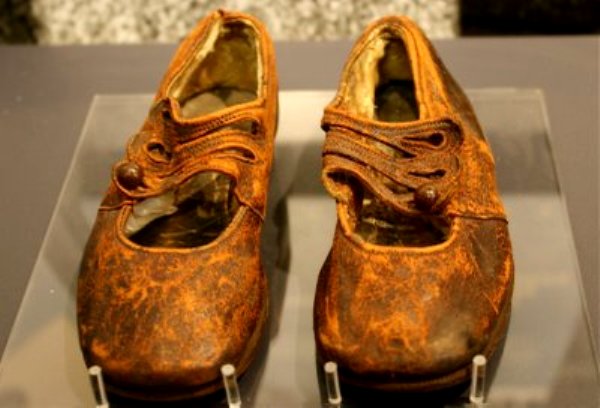Dispatches from Home – The Titanic’s Unknown Child.

On a foggy, cold day, April 17, 1912, the cable-laying ship Mackay-Bennett steamed out of Halifax, Nova Scotia. Her destination was the arctic-cold North Atlantic. Her job was to search for and recover the bodies of the Titanic’s dead passengers. The crew aboard, all volunteers, were paid double for this sad, grisly task.
The ship was loaded with embalming supplies, 100 coffins, and tons of ice in which to store the recovered bodies. Over 1500 passengers and crew were still aboard the Titanic when she split apart and sank. The Mackay-Bennett rescued 303 of those bodies, one of which was a 19-month-old, fair-haired toddler, Sidney Leslie Goodwin.
On April 10, 1912, Frederick and Augusta Goodwin and their six children boarded the Titanic at Southampton as Third-Class passengers. Due to a coal strike, they were transferred from the S.S. New York to the new, glamorous Titanic. They felt lucky indeed! The New World awaited, along with a new electrical engineering job at Niagara Falls for Frederick and a cozy cottage for Augusta and the children. The children, Lillian, Charles, William, Jessie, Harold, and baby Sidney, ranged in age from sixteen to 19 months old.
Not much is known about the Goodwins’ activities during the voyage, except that they may have been separated by sex at opposite ends of the ship—Frederick and his older sons in the bow and Augusta with Sidney and the girls in the stern. It was White Star policy to separate Third-Class passengers in this manner, although families were usually housed together.
However, they would have joined each other in the Third-Class public rooms and enjoyed the simple but plentiful food and the comradery of other passengers. Perhaps the older boys played games on deck. Augusta and the girls may have darned socks, crocheted, or played with little Sidney. Frederick and other older male passengers may have smoked a cigar while discussing their new jobs, hopes, and dreams.
Like many Third-Class passengers on the night of April 14, 1912, the Goodwins learned all too late about the mortal danger they were in. By the time they were either escorted to the boat deck or discovered their way through the ship’s labyrinth of rooms and hallways, the lifeboats had all been launched. The entire family perished in the sinking. Please go there with me now.
As he stood on the slanting deck with his family, I cannot help but wonder what thoughts raced through Fredrick’s mind. Horror? Guilt? Anger? And what about Augusta? The same as Fredrick, but with thoughts only a mother could fathom? Which one of my beautiful children will die first, gasping for breath in the freezing water? Who will I kiss last? Who will be the last to hear the words…I love you? Watching the water inch closer and closer to them, which child was first to ask the question no parent wants to hear: Papa? Mama? Are we going to die?
One of the first bodies recovered by the Mackay-Bennett was little Sidney. Out of a family of eight, his was the only body recovered. He was spotted floating face-up in some wreckage. He wore no lifejacket. Those who saw the boy said it was as if he were asleep. Unlike many of the bodies recovered, his body was perfectly preserved.
Pulling the child out of the water, the hardened, tough-as-nails sailor broke down in tears. The following information about little Sidney’s body was recorded that day: Body number 4. Male. Estimated age, 2. Hair, fair. Clothing: grey coat with fur on collar and cuffs, brown serge frock, petticoat, flannel garment, pink woolen singlet, brown shoes, and stockings. NO MARKS WHATEVER. Probably Third-Class.
Because there was no way to identify Sidney, his little body went unclaimed. The sailors aboard the Mackay-Bennett, shocked and saddened by this, paid for a monument, and Sidney was buried on May 4, 1912, in Halifax’s Fairview Lawn Cemetery, along with 121 other “unknowns.” A copper pendant placed in his coffin by the sailors read “Our Babe.”
For almost a century, Sidney’s gravestone read: “Erected to the memory of an unknown child whose remains were recovered after the disaster to the Titanic April 15, 1912”. However, because of a Halifax police sergeant’s sentimental heart, the boy didn’t stay unknown. Clarence Northover kept Sidney’s little shoes after helping guard the bodies and clothes of the recovered Titanic passengers when their bodies were brought back to Halifax.
The thought then was to burn the clothing to thwart souvenir hunters. But Northover didn’t want to burn the tiny shoes, so he put them in his drawer at the police station. They were passed down to one of his descendants after his death.
Fast-forward to the early 2000s. DNA testing was done on the shoes. The initial testing in 2002 pointed to two other Third-Class children as the probable child. Subsequent testing in 2007 conclusively identified the child’s remains as those of Sidney Leslie Goodwin. “It was the shoes that tipped it,” said genetics researcher Ryan Parr, vice president of Mitomics Inc. in Thunder Bay, Ontario, Canada. DNA extracted from Sidney’s exhumed remains and DNA provided by his little shoes helped positively identify his remains.
At long last, the Titanic’s Unknown Child was no longer unknown.



